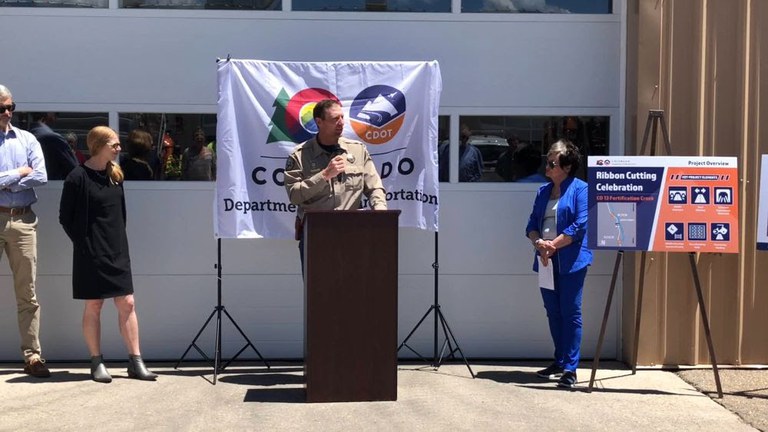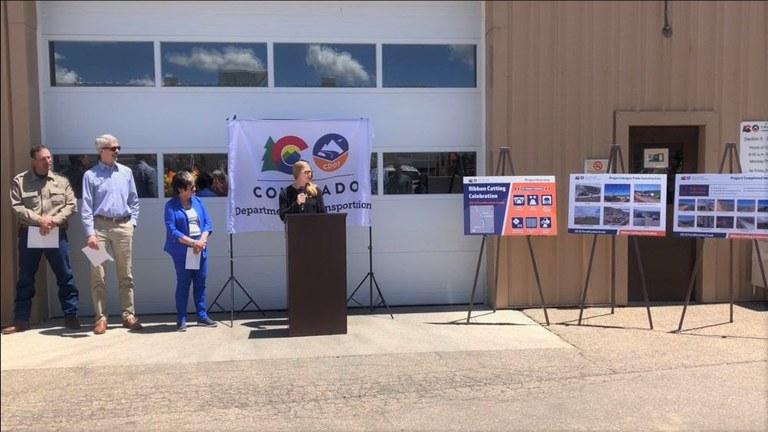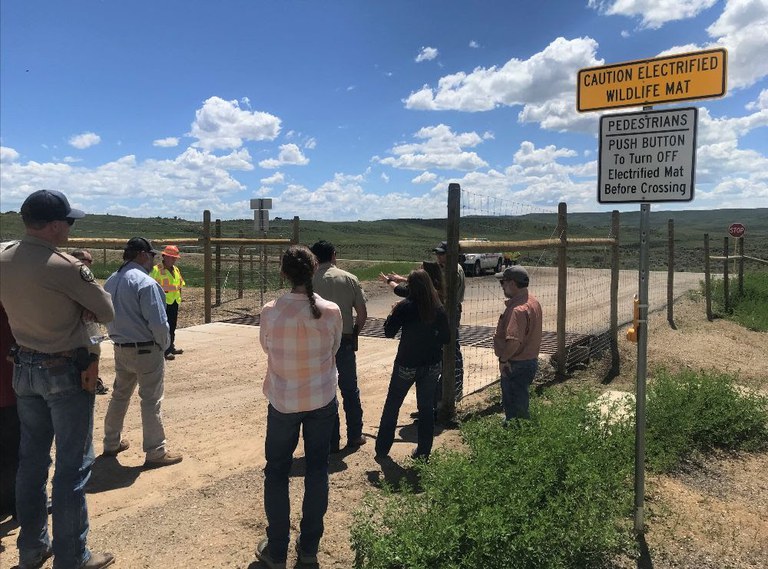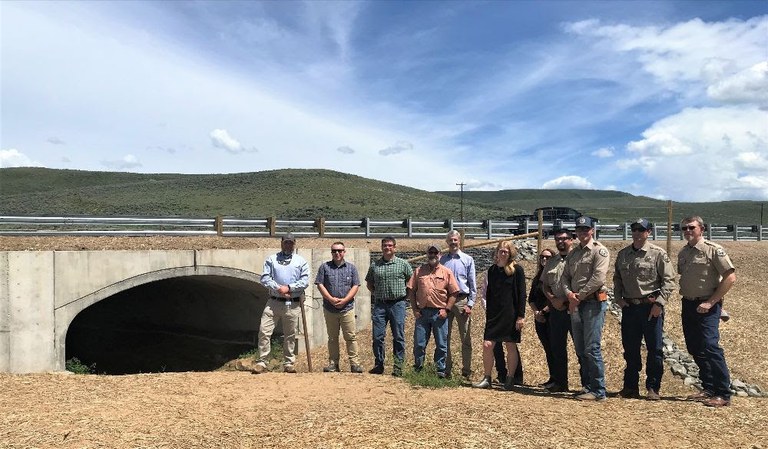CDOT, CPW and partner agencies celebrate completion of wildlife improvements on CO 13
News Release


Moffat County — The Colorado Department of Transportation, Colorado Parks and Wildlife, Federal Highway Administration, Bureau of Land Management, Northwest Colorado Transportation Planning Region and other partner agencies celebrated the completion of the Colorado Highway 13 Reconstruction and Road Widening and Wildlife Underpass project. The road safety project is located on CO 13 from north of Craig to the Wyoming border. Agency representatives gave spoken remarks on Thursday, June 8, followed by a tour of two significant wildlife safety improvements.
After the event, Governor Jared Polis emphasized the benefits of the project. “We are improving rural roads across Colorado, and these important investments are helping Coloradans and visitors get where they are going quicker and safer while protecting wildlife and avoiding costly wildlife-vehicle collisions," said Governor Polis.
At the celebration on Thursday, June 8, CDOT Executive Director Shoshana Lew noted how the project is part of a larger effort to improve rural state roadways. “Completing this project reflects the priority of the rural repaving program in CDOT’s 10-Year plan, which has made unprecedented investments in these critical but secondary routes,” said CDOT Executive Director Shoshana Lew. “These roadways are so important for providing redundancy in our system and the ability to bypass the interstates when necessary, and to have connectivity for rural communities.”
The project reconstructed CO 13 to meet current design standards, including wider shoulders, drainage improvements, a wildlife underpass, wildlife detection system and wildlife fencing. These improvements are designed to reduce wildlife-vehicle collisions, including a wildlife underpass and a detection system. Work on the project took place in 2021 and 2022.
“I am so thrilled to be in Craig to celebrate this project,” said Transportation Commissioner Kathy Hall. “CO 13 is a critical roadway for Northwest Colorado and serves as an important connector between Interstates 70 and 80 on Colorado’s Western Slope. These safety improvements will make traveling easier and safer for everyone from families to business owners to freight operators.”
Before the project, CO 13 had a high incidence of single vehicle run-off crashes, head-on crashes, and wildlife collisions. These high crash rates were directly related to the substandard roadway geometry, lack of shoulders and adequate recoverable slopes, and lack of wildlife fencing. Due to its substandard nature, frequent safety closures have previously been necessary due to inclement weather and crashes; alternative routes require several hours of out-of-direction travel. During construction, crews reconstructed the roadway, including full depth reclamation of existing asphalt. The work created a stronger, more even foundation. Crews also added 8-foot shoulders, corrected substandard geometry and placed rumble strips, along with a wildlife underpass, detection system and wildlife fencing.
“This is an exciting day,” said Federal Highway Administration Deputy Division Administrator Andrew Wilson, noting the new rumble strips, shoulders, and wildlife fencing designed to reduce the number of accidents on the roadway. “New safety improvements are anticipated to reduce delays of passenger vehicle travelers and the number of accidents related to poor commercial vehicle traction.”
The project is in cooperation and partnership with Colorado Parks and Wildlife (CPW), as the area is a popular corridor for wildlife. CDOT designed the project to reduce wildlife collisions while maintaining wildlife movement connectivity, including an arch bridge underpass for wildlife to safely travel underneath the roadway, as well as a section of roadway now equipped with a wildlife radar detection system. The detection system is connected to warning signage that will activate when an animal is detected entering the roadway. Newly placed high wildlife exclusion fence will guide animals to the underpass and radar detection area. On Thursday, officials toured the underpass and detection system.
“CDOT and CPW worked together to ‘think outside the box' and design the best wildlife safety improvements along CO 13,” said Colorado Parks and Wildlife Assistant Area Wildlife Manager Mike Swaro. “It was important to incorporate solutions because some of the largest migratory herds of mule deer and elk in Colorado—and perhaps the western United States—migrate through this area. This can mean as many as tens of thousands of animals need to cross CO 13 and make 60-70 mile migrations east to west from as far as the Continental Divide.”

As part of the detection system, crews installed two electrified wildlife deterrent mats, named ZapCrete Mats, on the project adjacent to the newly installed cattle guards on Moffat County Roads 38 and 40. The mats paired with cattle guards are in lieu of using larger wildlife guards. The wildlife radar detection system and ZapCrete Mats are the first of their kind being installed and tested in Colorado. Now that the project is complete, a study will be conducted to determine the success of the detection system, ZapCrete mats, game ramps and wildlife fencing concept.
“This project is part of a larger effort by the National Fish and Wildlife Foundation to contribute to wildlife safety projects in Colorado,” said Seth Gallager, National Fish and Wildlife Foundation Program Director for the Grasslands and Mountain West Rocky Mountain Regional Office.“We have partnered with CDOT on four projects around the state since 2018, granting $1.4 million which was matched by CDOT and partners for a $22 million overall impact. We look forward to future opportunities to partner with CDOT, CPW and other agencies.”

“It takes a lot of teamwork to complete this kind of intensive project,” said Assistant Project Engineer Jeff Goulet. “In addition to the wildlife underpass and wildlife detection system, project required earthwork and excavation; multiple retaining walls; nearly 8,000 feet of guardrail; 22 new culverts; 212,000 cubic yards of embankment placed to widen the road and add shoulders; 1,360 concrete yards of poured concrete; and 54,500 linear feet of new wildlife fencing. Other improvements are culvert removals and replacements, culvert slip lining, full depth reclamation of the existing asphalt, placement of new road base course, asphalt paving, shouldering, fencing, guardrail, striping, and signing.
